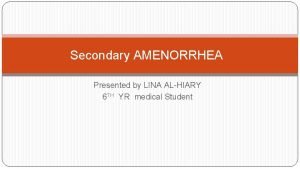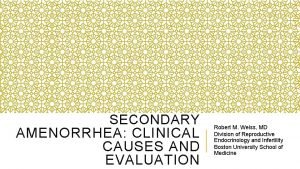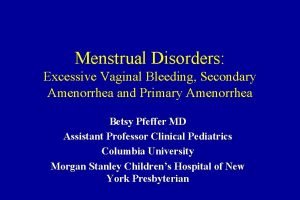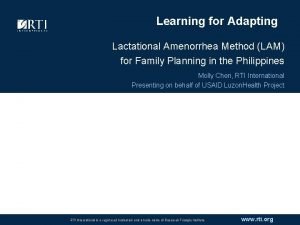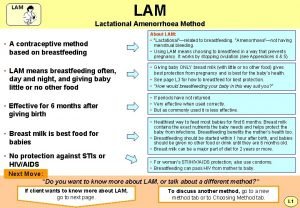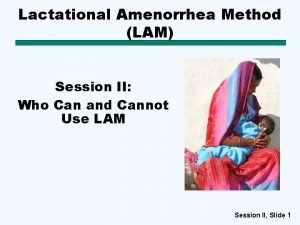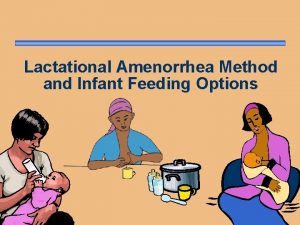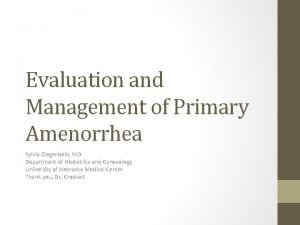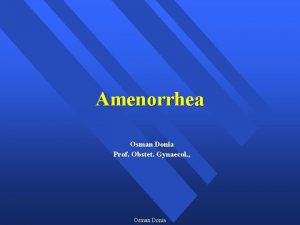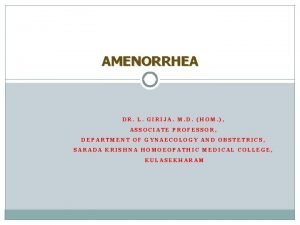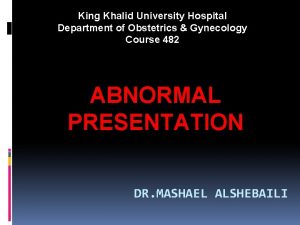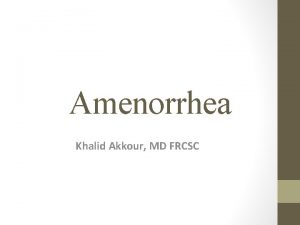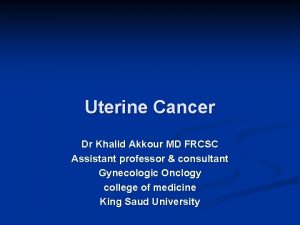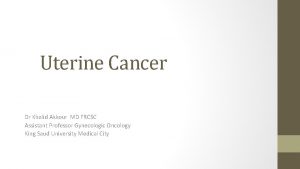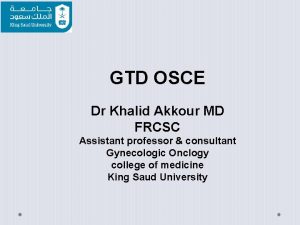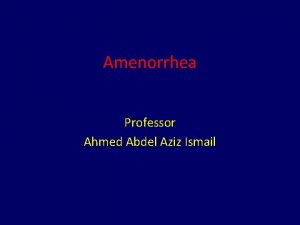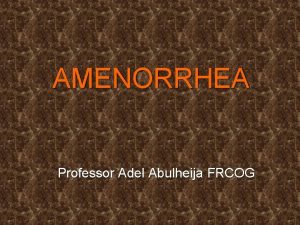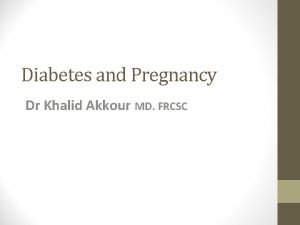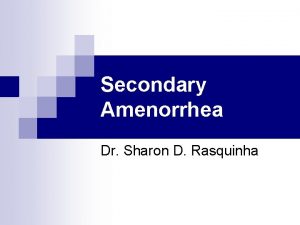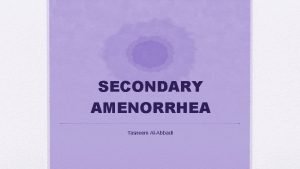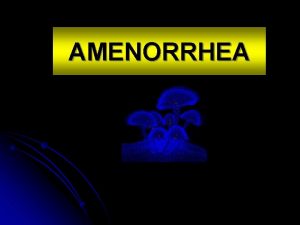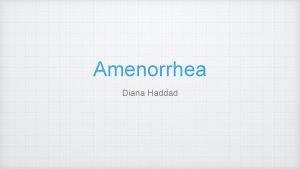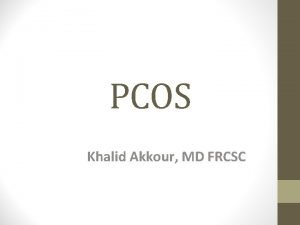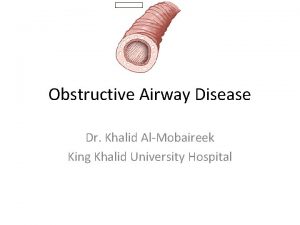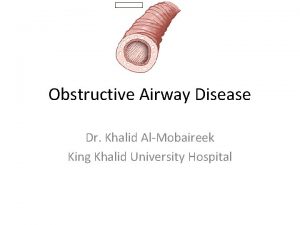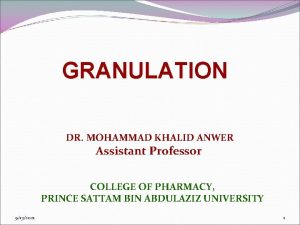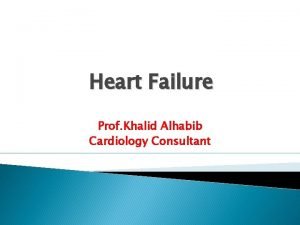Amenorrhea Dr Khalid Akkour Assistant professor and consultant






























- Slides: 30

Amenorrhea Dr. Khalid Akkour Assistant professor and consultant Gynecologic oncologist Department of Obstetric and Gynecology College of Medicine, King Saud University

Objectives. To discuss the prevalence & pathogenesis of amenorrhea. To discuss the clinical presentation of amenorrhea. • To discuss the various types of work-up for amenorrhea. To discuss the management for amenorrhea.

Definition Primary amenorrhea. v Failure of menarche to occur when expected in relation to the onset of pubertal development. • No menarche by age 16 years with signs of pubertal development. v No onset of pubertal development by age 14 years. Secondary amenorrhea. v Absence of menstruation for 3 or more consecutive cycles in a previously menstruating women of reproductive age.

Events of Puberty Thelarche – breast development. v. Requires estrogen. Pubarche/adrenarche – pubic hair development. v. Requires androgens. Menarche – the first menses. v Gn. RH from the hypothalamus. v. FSH and LH from the pituitary. v. Estrogen and progesterone from the ovaries. v. Normal outflow tract.

Classification. Hypothalamic Amenorrhea. Pituitary Amenorrhea. Ovarian Amenorrhea. Uterine Amenorrhea. Other.

Etiology – Hypothalamic. Primary. Congenital Gn. RH deficiency. Weight loss. Organic disease. Constitutional. Secondary. Weight loss – Anorexia nervosa. Exercise. Organic disease. Emotional stress. Pseudocyesis.

Anorexia Nervosa BMI < 17 kg/m 2 -> menstrual irregularity and amenorrhea. Hypothalamic suppression. Mean age onset ( 13 -14 years) Low estradiol -> risk of osteoporosis.

Exercise-associated amenorrhea Common in athletic women Eating disorders have a higher prevalence in female athletes than nonathletes. Hypothalamic disorder caused by abnormal Gn. RH pulsatility – results in impaired gonadotrophin levels, particularly LH and subsequently low estrogen levels.

Contraception related amenorrhea Post pill amenorrhea is not an entity. Depot medroxyprogesterone acetate – Up to 80% of women will have amenorrhea after 1 year of use – reversible. A minority of women taking the progesterone- only pill may have reversible long term amenorrhoea due to complete suppression of ovulation.

Etiology – Pituitary. Primary Hyperprolactinaemia. Pituitary failure. Secondary. Hyperprolactinaemia. Sheehan’s syndrome. Organic disease.

Hyperprolactinaemia. Increased prolactin Suppresion of Gn. RH Supression of FSH, LH Impaired follicular development

Hyperprolactinaemia – Causes Drug Induced Prolactinoma Phenothiazines Tricyclic Antidepressants Methyldopa Microadenoma Resperine Morphine Cimetidine Macroadenoma Primary hypothyroidism Idiopathic

Sheehan’s syndrome. Pituitary inability to secrete gonadotropins. Pituitary necrosis following massive obstetric hemorrhage is most common cause in women. Diagnosis. v History and E 2, FSH, LH + other pituitary deficiencies ( Decreased TSH and ACTH) Treatment. v. Replacement of deficient hormones.

Etiology – Ovarian. Primary. Secondary. v Ø Ø v v v v Gonadal dysgenesis Chromosomally incompetent. Turner’s syndrome (45 X 0) Chromosomally competent Pure gonadal dysgenesis (46 XX) v Ovarian agenesis v Chemotherapy and radiotherapy. PCOS. Resistant ovary. Hormone producing tumours. Chemo/radiotherapy. Gonadal dysgensis

Etiology – Uterine. Primary. Secondary. v Utero-vaginal agenesis. v Asherman’s syndrome.

Mayer-Rokitansky-Kuster. Hauser Syndrome Utero-vaginal agenesis 15% of primary amenorrhea. Normal secondary development & external female genitalia. Normal female range testosterone level Absent uterus and upper vagina & normal ovaries. Karyotype 46 XX. 15 -30% - Renal, skeletal and middle ear anomalies.

Imperforate Hymen Congenital disorder. Hymen without an opening obstructs the vagina. Failure to perforate during fetal development – failure of sinovaginal bulbs to canalize. Surgical.

Imperforate Hymen

Haematocolpos & Haematometra

Asherman’s syndrome. Adhesions/ fibrosis of endometrium associated with dilation and curettage. Destruction of stratum basalis of endometrium. Diagnosis – Hysteroscopy. Treatment – Uterine sound, operating hysteroscopy, IUCD, Estrogen.

Congenital Adrenal Hyperplasia. Autosomal recessive trait. 21 -hydroxylase deficiency. +ve Family history. Resembles PCOS. High 17 -OH progesterone blood level. Presence of uterus and upper vagina. Treatment: v. Cortisol replacement + Corrective surgery.

Androgen Insensitivity. Testicular feminizing syndrome. Normal breasts but no sexual hair. Normal looking female external genitalia. Absent uterus and upper vagina. Karyotype 46, XY. Male range testosterone level. Treatment: v. Gonadectomy + HRT.

History. RULE OUT PREGNANCY. Menstrual history: age at menarche, LMP, previous menstrual pattern, diet, medications, stress. Galactorrhea, radio/chemotherapy, weight loss/gain. Intense exercise/ dieting Estrogen deficiency – hot flushes, night sweats.

Physical. Tanner staging – breast development, pubic hair distribution. Thyroid examination. Hair distribution – Androgen excess/ insensitivity External genitalia and vagina – atrophy, clitoromegaly, imperforate hymen. Palpation of uterus/ ovaries.

Investigations. Progesterone challenge to assess estrogen status. v Medroxyprogesterone acetate 10 mg for 10 days. v. Uterine bleed within 2 -7 days - +ve test. v. Withdrawal bleeding occurs – adequate estrogen. v No bleeding – hypoestrogenism. Bloodwork investigations. Ultrasound. Karyotype if indicated.


Treatment. Hypothalamic dysfunction. v Stop drugs, stress manangement, moderate nutrition & exercise. v Clompihene citrate if pregnancy desired. v OCP to induce menstruation. Hyperprolactinemia. v Bromocriptine. v Surgery for macroadenoma Hypoestrogenism. v Karyotype. v Removal of gonadal tissue if Y chromosome present. PCOS. Supplemental vitamin D + calcium intake along with moderate weight bearing exercises to combat bone degeneration.

Conclusion Primary amenorrhea. v. The overall reproductive prognosis is poor. v. Only the patients with idiopathic pubertal delay can be expected to have normal reproductive capacity. v. It is possible for most patients to achieve satisfying sexual function with appropriate management. Secondary amenorrhea. v. As all fields of clinical medicine, the treatment of patients should be directed against the underlying disease state. v. Clinical reviews should be held 3 -6 months.

Take home points.

To end… Primary amenorrhea – absence of menses by age 16. Secondary amenorrhea – absence of menses for > 3 consecutive cycles. 3 main mechanisms of pathophysiology of amenorrhea. v. Failure/malfunction of hypothalamic-pituitary-gonadal axis. v. Absence of end organs. v. Obstruction of outflow tract. *Test for Pregnancy. Progesterone challenge. Treat underlying disease state/ symptomatic treatment.
 Promotion from associate professor to professor
Promotion from associate professor to professor Cuhk salary scale 2020
Cuhk salary scale 2020 Anovulation who classification
Anovulation who classification Labs for secondary amenorrhea
Labs for secondary amenorrhea Amenorrhea approach
Amenorrhea approach Cause amenorrhea
Cause amenorrhea Lactational amenorrhea
Lactational amenorrhea Lam contraception method
Lam contraception method Lactational amenorrhea method
Lactational amenorrhea method Lactational amenorrhea
Lactational amenorrhea Causes of primary amenorrhea
Causes of primary amenorrhea Prolectinoma
Prolectinoma 2ry amenorrhea
2ry amenorrhea Amenorrhea
Amenorrhea Khalid nationality
Khalid nationality Khalid farhan course google drive
Khalid farhan course google drive Brow presentation birth
Brow presentation birth Khalid bakri
Khalid bakri Complete the tag question your name is ali khalid
Complete the tag question your name is ali khalid Samra khalid
Samra khalid Khalid mustafa
Khalid mustafa Archaeplastida
Archaeplastida Dr khalid jamal
Dr khalid jamal Khalid alsadhan
Khalid alsadhan Dr khalid waheed
Dr khalid waheed Dr. khalid bazaid
Dr. khalid bazaid Khalid al dossary
Khalid al dossary Cherki karkaba
Cherki karkaba Cipralex side effects
Cipralex side effects Dr paul howat
Dr paul howat Dr sana khalid
Dr sana khalid


